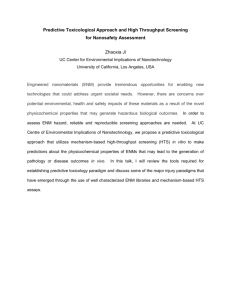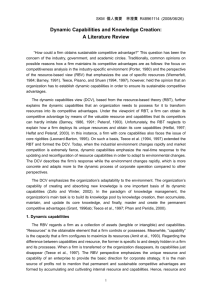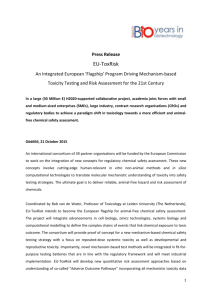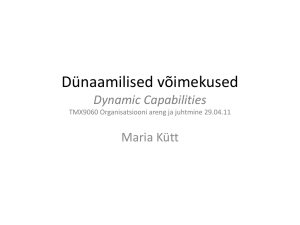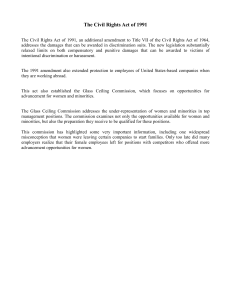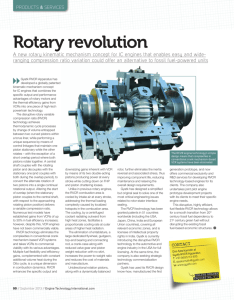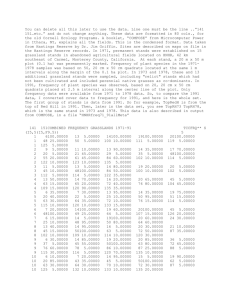NEW PRODUCT DEVELOPMENT IN THE MECHANISM
advertisement
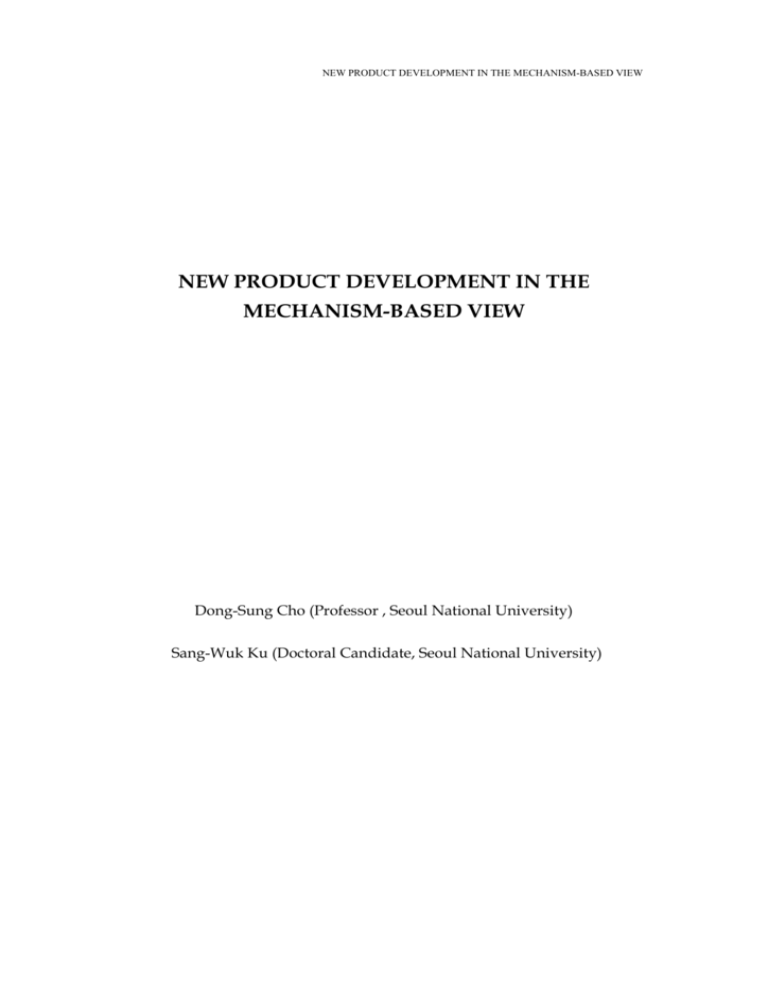
NEW PRODUCT DEVELOPMENT IN THE MECHANISM-BASED VIEW NEW PRODUCT DEVELOPMENT IN THE MECHANISM-BASED VIEW Dong-Sung Cho (Professor , Seoul National University) Sang-Wuk Ku (Doctoral Candidate, Seoul National University) NEW PRODUCT DEVELOPMENT IN THE MECHANISM-BASED VIEW NEW PRODUCT DEVELOPMENT IN THE MECHANISM-BASED VIEW Dong-Sung Cho (Professor , Seoul National University) Sang-Wuk Ku (Doctoral Candidate, Seoul National University) <Abstract> This paper presents the mechanism-based view (MBV) as a new paradigm of strategic management theory in comparison with the traditional theoretical streams such as subjectbased view, environment-based view, resource-based view, dynamic capability, and process. I also apply the MBV to identify mechanism factors in new product development of firms. For this, this paper analyzes theories related to new product development and shows the mechanism mapping to find the new product development mechanisms. The mechanism-based view (Cho and Lee, 1998; Cho, 2004) explained the deficiency of subjectbased view, environment-based view, resource-based view, dynamic capability, and process. It has coordinating, learning and selecting attributes, and the characteristics of causal ambiguity, path dependency and inertia. And also, MBV explains the combination, the sequence and the timing of applying subject, environment and resource related factors to the firm. This paper (portion of the paper?) is composed of five chapters as follows: Chapter one shows the outline of the paper. This chapter specifies research background, objectives and scope. Chapter two analyzes the past researches of new product development. Chapter three introduces the mechanism-based view along with the comparison with similar theories and their differences. Chapter four shows the new product development mapping to identify the related mechanisms. Finally, I summarize the differentiated strategic implications of the mechanism-based view compared to other strategic management theories and propose the future empirical research topic. Key words: mechanism-based view (MBV), new product development, mechanism mapping ◈ Contents ◈ 1. Introduction 2. New Product Development 3. Mechanism-Based View 4. New Product Development Mechanism 5. Discussion and Conclusion <국문초록> <References> NEW PRODUCT DEVELOPMENT IN THE MECHANISM-BASED VIEW 1. Introduction 1) Research Objectives A firm faces rapidly changing environments in the various industries in which it participates. According to the environmental changes, a firm should manage its limited resources and competences. For this, a firm’s management considers seriously restructuring or investment. Many scholars have studied various strategic management theories such as resourcebased view (e.g., Barney, 1986, 1991; Dierickx and Cool, 1989), subject-based view, environment-based view, dynamic capability (e.g., Eisenhardt, 2000; Makadok, 2001; Teece, 1997; Helfat, 2000; Zollo and Winter , 2002), and so on. However, there is great limitation to explain the many strategic problems regarding the management of the firm. Therefore, the aim of this study is to show how the mechanism-based view (Cho and Lee, 1998; Cho, 2004) can solve and explain the problems and limitations of the previous researches. Particularly, the main focus will be on how new product development can be understood by the mechanism-based view compared to other strategic management theories. 2) Research Scope and Outline This paper is composed of three stages. First, I would like to understand the theories of new product development. Second, I need to show what the mechanism-based view is and what should be understood in this new strategic paradigm. Third, new product development mechanism should be explained by mapping with input factors such as subjects, environments and resources. Finally, I suggest what specific benefits provide strategic management researches from the mechanism-based view. 2. New Product Development 1) Literature Review and Analysis New product development (NPD) is a process of linking technology and customers (Dougherty, 1992). On the demand side, customers need to seek certain benefits of products. On the supply side, firms provide certain benefits by applying their technologies and products. The product development literature has examined the determinants of new product NEW PRODUCT DEVELOPMENT IN THE MECHANISM-BASED VIEW success (Cooper, 1993; Montoya-Weiss and Calantone, 1994). These studies identified a positive impact of synergy between a firm and projects on the performance of new product development (Cooper and de Brentani, 1991; Cooper and Kleinschmidt, 1993; Song and Parry, 1997; Zirger and Maidique, 1990). In other words, new products would be more successful when they closely fit a firm’s competences. A firm can gain market leadership by marketing new products to achieve growth and profitability (Iansiti, 1995). A company can also well understand customer’s needs and achieve improving responsiveness to the market (Day, 1999). To judge the viability of a new product, a company should understand two main dimensions: technological assessment and market assessment. Technological assessment involves judging the technological feasibility of the product. Market assessment involves judging the market potential of the product. The previous researches have not considered the reverse relationship between product innovation and competence. In other words, a company should understand the effect of new product development on its competences. It needs the key market related and technically related resources to accomplish the performance goals (Danneels and Kleinschmidt, 2001; Mitchell, 1992; Moorman and Slotegraaf, 1999). Generally, new product development requires the competences relating to technology and customers. These two types of competences for new product development composed of two dimensions such as new and existing technological competences and new types of customer competence. The firm competences regarding customer and technology are reciprocally related with the tangible and intangible resources. The firm gains customer competence by serving benefits to certain customers. Customer competence is composed of such marketrelated resources as: knowledge of customer needs, preferences, and purchasing behaviors, distribution and sales channels to customers, brand reputation, and communication channels for exchange of inform]]ation between the firm and customers during development and commercialization of new products. Successful technology commercialization for new product development has multiaspects including: (1) utilize it for developing a large number of new products and process technologies (Zahra and Covin, 1993); (2) develop radically new products (Zahra, 1996); (3) introduce new products to the market (Stevens, Burley, and Divine, 1999); and (4) create new knowledge (Leonard-Barton, 1995). A firm introduces new products and technologies with more speedy technology commercialization than its competitors. This propensity of a firm attacks its competitors, reduce costs, improve quality, absorb new technologies, expedite learning from customers (Eisenhardt, 1990; Iansiti, 1995), and improve new market performance (Calantone, Vickery, and Droge, 1995). NEW PRODUCT DEVELOPMENT IN THE MECHANISM-BASED VIEW <Figure > Research summary on new product development Firm competences / Resources NPD Technology Process Performance Customer (Day, 1999) (Dougherty, 1992) Technology Assessment Market Assessment (Cooper and de Brentani, 1991; Cooper and Kleinschmidt, 1993; Kleinschmidt and Cooper, 1991; Song and Parry, 1997a, 1997b; Zirger and Maidique, 1990; Danneels and Kleinschmidt, 2001; Mitchell, 1992; Moorman and Slotegraaf, 1999) Growth & Profit (Iansiti, 1995) Judgment of viability of a new product 2) Research Implications These examples of previous research have limitations on the role of new product development for firm innovation. In the resource-based view, core capabilities paradoxically enable and impede product innovation (Leonard-Barton, 1992). Core capabilities expedited project development aligned with those capabilities. Generally, core capabilities have the attributes such as employee knowledge and skills, administrative systems, technical systems, and values and norms. However, the projects with insufficient attributes were constrained. Leonard-Barton argued that firms have difficulties in utilizing and maintaining their capabilities, and yet avoiding their dysfunctional effect by continuously renewing and replacing them. Product development is a dynamic capability of the firm due to resource reconfiguration (Eisenhardt and Martin, 2000). The product development can be one of the mechanisms by which firms create, integrate, recombine, and shed resources. However, I have a doubt as to whether resource-based view and dynamic capability can explain the strategic values of the product development, since they can not explain composition of resources, sequence of resource allocation, and timing to transfer to each phase in the product development. Additionally, the dynamic capabilities cannot explain the negative influence on the firm performance. Therefore the mechanismbased view (Cho and Lee, 1998; Cho, 2004) explained in the following chapter can be considered the best alternative to explain the deficiency of resource-based view and dynamic capability. NEW PRODUCT DEVELOPMENT IN THE MECHANISM-BASED VIEW 3. Mechanism-Based View 1) Comparison with Similar Theories Dynamic Capability Dynamic capability is defined as a core theory in explaining corporate heterogeneity and sustainable competitive advantage in dynamic markets. Compared to resourcebased view as a long-lasting core strategic management theory, dynamic capability explains sustainable corporate competitive advantage under rapidly changing competitive environment. However, since customer preference, technologies, and competitive structure are more rapidly changing, firms can not continuously retain competitive superiority with the established market status and resources. Dynamic capabilities can improve corporate productivity and expand resources. The values of resources would be potential before being developed by dynamic capabilities. They intend to obtain the required resources from the external of a firm to maximize business performance by learning knowledge and resources of business partners and seeking vertical integration with new business opportunities. The view of dynamic capabilities can be interpreted as the extension of resource-based view (Eisenhardt and Martin, 2000). They also can be very important asset to obtain sustainable competitive advantage and superior market status by utilizing valuable resources within the organization. Valuable resources in dynamic markets in which retained technologies, market demands, and competitive status are important are critical strategic factors in a firm. However the integration of knowledge and technologies depends on the firm itself. Makadok (2001) studied the integrated perspective of dynamic capabilities and resource-based view for profit creation and also explained two important mechanisms of resource and competence building. He argued that firms could expect to obtain the profits through resource building mechanism in the perspectives of how valuable the proprietary resources are in integrating with other resources. On the other hand, resource building mechanism can be the perspective to compare between resources and competences. In other words, the resource building mechanism is more realistic before building resources and the competence building mechanism is more effective after building resources for profit creation. Eisenhardt (2000) and Teece, Pisano and Shuen (1997) defined the dynamic capabilities as the capabilities to create sustainable competitive advantage in dynamic markets. Teece (1994) and Zollo (2002) also explained the dynamic capabilities as capabilitybuilding capabilities which are integrated strategic formation and standardize and refine production processes to improve corporate performance. NEW PRODUCT DEVELOPMENT IN THE MECHANISM-BASED VIEW Zollo and Winter(2002) also defined the dynamic capabilities as capability-building capabilities. Firms obtain knowledge rapidly through dynamic capabilities to absorb, allocate, and integrate them. Such dynamic capabilities exist within the organization and strategic processes. Therefore they can be identified with specific functional processes such as new product development, strategic alliances, strategic decision making, and research and development (Eisenhardt and Martin, 2000). Even though dynamic capabilities are idiosyncratic and path dependent on one another, they show the similarities to each of the firms in some cases. That is called the ‘best practice’. They are also similar to routine as a traditional concept. Routine can be detailed and stable processes with expectable results in dynamic markets. However, routine is too simple and experimental to expect the results. Teece, Pisano and Shuen(1997) defined dynamic capabilities as a set of required capabilities for new product and process development in changing market environment. Eisenhrdt and Martin (2000) defined dynamic capabilities as the processes of organizational and strategic routines to integrate and reallocate the resources in changing market environment. Zollo and Winter (2002) explained that dynamic capabilities are developed through the processes generate and control standardized operational routines with operational patterns for the improvement of organizational capabilities. They also explained learning mechanism as dynamic sources. In short, the perspectives that dynamic capabilities are the integration of processes can be correlated with mechanism-based view. <Figure > Research summary on dynamic capability Integration of DC and RBV (Makadok, 2000) RBV Extension of RBV Dynamic Capability (Eisenhardt, 2000) Capability-building capabilities Process The processes of organizational and strategic routines (Teece, 1994; Zollo, 2002; Eisenhardt, 2000; Halfat, 2000; Eisenhardt and Zollo, 2000) (Teece, 1997; Eisenhardt and Martin, 2000; Zollo and Winter, 2002) Process Business processes are actions that firms engage in to accomplish business purposes or objectives. They can be the routines or activities that a firm develops to get something done (Nelson and Winter, 1982; Porter, 1991). These business processes impact on a NEW PRODUCT DEVELOPMENT IN THE MECHANISM-BASED VIEW firm’s overall performance in the marketplace. Since the processes tend to be path dependent, casually ambiguous, and socially complex, they can exploit intangible resources. These intangible resources are more likely to be a source of competitive advantage than business processes that exploit tangible resources (Lippman and Rumelt, 1982; Itami, 1987; Dierickx and Cool 1989; Barney, 1991). Van de Ven (1992) explained the processes in strategic management can be divided into three things. First, processes can be defined as a logic explaining the cause-and-effect relationship between dependent variables and independent variables. This concept is used in inputprocess-output model. That explains that independent variables role as inputs and dependent variables as outputs in the cause-and-effect relationship. Second, generally processes can be explained as procedure concept in individual and organizational behaviors such as communication frequency, working orders, decision making methodology, strategy formulation, and implementation. Conceptual constructs are required to measure the processes as variables. The attributes of the conceptual constructs should be shown in numerical scale. For example, when you analyze how much strategic decision making processes can have an affect on management understanding about causes and effects including within-firm and environment, the conceptual constructs should be defined as variables with the attributes of the fixed entities. In this case, the conceptual constructs measure changes in each different time spot. However the sequence of events should be explained to understand how the changes have happened. For this, the third concept of processes is required to be understood. This concept explains the processes as developmental event sequence. The processes in this concept explain about how changes are developed as time goes by and what are the patterns of changes. It focuses on the procedure of events, behaviors, and stages in historical developmental perspectives. Cho (2004) explained the processes and mechanisms in the perspective that a stepwise sequence of activities which stems from causes and results in effects of a certain matter or phenomenon. The mechanism is a bundle of processes that take place within a system that are repeatedly exercised by the subject in an effort to link external environment and internal resources. NEW PRODUCT DEVELOPMENT IN THE MECHANISM-BASED VIEW <Figure > Research summary on process • Exploiting intangible resources • A logic explaining the cause-and effect relationship Bundle of processes • Procedure concept in individual Mechanism (Cho, 2004) and organizational behaviors • Developmental event sequence 2) Explanation of Mechanism-Based View Basic Elements of Mechanism A Mechanism has basic elements of subject, environment and resource. These basic elements provide the perspectives on strategy such as the Subject-Based View (SBV), the Environment-Based View (EBV), and the Resource-Based View (RBV). <Figure > Research summary on SBV, EBV and RBV EBV RBV SBV Industrial Industrial organization organization (Porter, (Porter, 1980) 1980) A A bundle bundle of of resources resources (Penrose, (Penrose, 1959) 1959) TMT TMT Resource Resource dependence dependence theory theory (Pferrer, (Pferrer, 1978) 1978) RBV RBV of of the the firm firm (Wernerfelt, (Wernerfelt, 1984) 1984) Population Population ecology ecology theory theory (Hannan, (Hannan, 1977) 1977) Upper Upper echelons echelons perspective perspective (Hambrick, (Hambrick, 1984) 1984) Leadership Leadership (Hambrick, (Hambrick, 2001) 2001) Sustainable Sustainable competitive competitive advantage advantage (Nelson, (Nelson, 1991) 1991) Institutionalism Institutionalism (Scott, (Scott, 2001) 2001) Heterogeneity Heterogeneity Immobility Immobility Resource Resource heterogeneity heterogeneity (Wernerfelt, (Wernerfelt, 1984) 1984) VRIO VRIO // VRIN VRIN (Barney, (Barney, 1991) 1991) Intangible Intangible asset asset (Grant, (Grant, 1991) 1991) Organization Organization learning learning (Collis, (Collis, 1994) 1994) Differentiated Differentiated values values of of resources resources (Nelson, (Nelson, 1991) 1991) Routine Routine Core Core competence competence (Prahalad, (Prahalad, 1990) 1990) Productivity Productivity// Resource Resource extension extension Resource Resource acquisition acquisition // Capability Capability acquisition acquisition (Makadok, (Makadok, 2001) 2001) Knowledge Knowledge management management (Nonaka, (Nonaka, 1985) 1985) Combination Combination of of processes processes (Eisenhardt, (Eisenhardt, 2000) 2000) Experiences Experiences Dynamic Dynamic capability capability (Teece, (Teece, 1997) 1997) Bounded Bounded rationality rationality Path Path dependence dependence Evolutionary Evolutionary economics economics Learning Learning mechanism mechanism (Zollo, (Zollo, 2002) 2002) Survival Survival Inheritance Inheritance Inertia Inertia Selection Selection NEW PRODUCT DEVELOPMENT IN THE MECHANISM-BASED VIEW Structural Elements of Mechanism The structural elements of a mechanism can be comprised of composition of resources, sequence of resource allocation, and timing to transfer to each phase. One thing I should understand here is to understand a mechanism does not have the characteristics of rareness, imitability and non-substitutability. That is, a mechanism is a neutral element not to influence on differentiated resource value. Composition As most companies have firm specific resource composition, they finally retain similar resources. However they are not similar in the sequence and the timing of resource acquisition. Even though Samsung Electronics and LG Electronics have similar tangible and intangible resources, Samsung Electronics takes more business opportunities by selecting new product development capabilities and LG Electronics by strengthening quality control as strategic priorities. The performance differences could be accomplished by the sequence and the timing of resources, not by themselves. Therefore resource composition itself can not bring competitive advantages. Sequence It might be difficult for a firm to acquire various resources simultaneously. Generally most companies focus on acquiring selectively specific resources and wait for acquiring other resources. The combining sequence of resources can be formed in this process. As resources are combined in order, capabilities acquired in the process are heterogeneous and competitively differentiated. That is, competitive advantages could be brought by the combining sequence of resources, not by the differentiated advantages. This can not be explained with RBV, but MBV can explain this phenomenon with the combining sequence of resources. However the sequence of resources itself can not have attributes of ‘RIN’ in RBV. If the sequence of resources can have appropriate combination, a firm can take sustainable competitive advantage. Therefore MBV can overcome limits on the attributes of ‘VRIN’ in RBV to create sustainable competitive advantage. Timing The timing of resource acquisition has influence on the sequence. Basically MBV’s three axes of composition, sequence and timing are neutral in value. The value-neutral NEW PRODUCT DEVELOPMENT IN THE MECHANISM-BASED VIEW mechanism produces positive or negative values at specific time. This explains the structure of mechanism is influenced by the law of diminishing utility. The usefulness of resources are diminished by the differences in resource acquisition sequence. It is different with diminishing resource differentiation. Therefore a firm has different competitive advantage factors according to sequence and timing with similar resource composition. I can explain the structural elements of a mechanism in the perspective of the process. A firm generally draws process maps to understand the characteristics of composition, sequence and timing of activities within and out of organizations. To sustain competitive advantages, a firm should retain very efficient and effective activity flows as processes. It should compose activities efficiently and effectively with very streamlined sequence and optimal timing. As the figure shows the example of process mapping, general firm processes are composed of planning, development, operation and evaluation. These company processes can be divided into several key business processes and sub-processes. I will be able to identify which sub-processes are the mechanisms for firms’ sustainable competitive advantages. <Figure > Example of process mapping Company processes Planning Development Operation Evaluation Key business processes & sub processes Site Planning Community & Partnership Site Specification Ordering Site Implementation Planning Settlem -ent Development Strategic Planning Market Research Capability Evaluation Implemen -tation Planning Requirem -ent Definition Project Manag ement Product Planning Supplier Selection Delivery Daily Adjustm -ent Purchasing Stock Retenti -on Information Production Monthly Adjustm -ent Evaluation Contents Merchandising Evalua tion Adjustment Order Processing Data Input & Mining Performance Analysis Implemen -tation Alternatives Customer Service Marketing Planning Marketing Goal Setting Implementati -on Planning Preparation Customer Response Implementation Supporting processes Accounting Accounting and and Finance Finance Human Human Resource Resource Management Management Investor Investor Relations Relations Attributes of Mechanism What factors account for the lasting success of firms? In an attempt to answer this question, this paper reviews three existing perspectives of strategic management: NEW PRODUCT DEVELOPMENT IN THE MECHANISM-BASED VIEW subject-based, environment-based, and resource-based views. It then proposes a new perspective -- the "Mechanism-Based View (MBV)", which focuses on the interactions among subject(s), environment(e), and resource(r) and integrates them into a mechanism(M). The central concept of this emerging perspective is the mechanism, which is composed of three attributes---coordinating, learning and selecting mechanisms. The "coordinating" mechanism is the process by which the subject utilizes resources in response to environmental changes. This coordinating mechanism is evolved through "learning" processes, and only the fittest is "selected" in the long run. The selection of a mechanism by the environment is due to the self-destructive nature inherent in the learning process. The Mechanism-Based View(MBV) perspective suggests that a firm creates unique value and differentiates it from the competitors when the mechanism functions properly and determines the path of its growth. Consequently, it is the mechanism--not the subject, environment, or resources--that should be a unit of analysis in exploring the origins of a firm's growth or determinants of its behavior. This perspective can be used in developing and evaluating various levels of analysis, such as competitive strategy at the business level, diversification strategy at the corporate level, and industrial policies at the country level. <Figure > Conceptualization of MBV by Dong-Sung Cho, 2004 Process Input Output Subject Mechanism Environment Performance Resource Process Influence Feedback According to figure , I can classify strategic factors into subject, environment, resource, mechanism, dynamic capability (Eisenhardt and Martin, 2000; Makadok, 2001; Teece, NEW PRODUCT DEVELOPMENT IN THE MECHANISM-BASED VIEW 1997; Zollo and Winter, 2002), and process (Van de Ven, 1992; Cho, 2004) to analyze the effects of specific mechanisms on firm performance. <Figure > Flow chart for distinguishing S, E, R, and M by Dong-Sung Cho, 2004 Yes Does it only exist outside of the analytic unit? E No Does it exist across inside and outside of the analytic unit? Yes Cross-over M No Is it the subject itself or attributes of the subject? Yes S No Yes Can it change the subject? Subject-changing M No Can it be acquired? Will it exist when the unit dies? Yes R No Is it something that changes the resources in the short-run? Yes R-changing DC No Is it something that is developed over time? Yes System-building M No Is it something that changes the mechanism? Yes No M-changing DC Process Mechanism-based view has the characteristics of coordination, learning, and selection as follows. Coordinating mechanism A corporation corresponds to environmental changes and allocates efficiently resources through resource utilization processes. In this perspective, the essence of a corporation is a mechanism. Corporations have different mechanisms because they confront different environment, different decision making results by subjects, and different retaining resources. The more efficient resource utilization mechanism the subject confronts environmental changes, the more competitive advantages the corporation can sustain in the market. NEW PRODUCT DEVELOPMENT IN THE MECHANISM-BASED VIEW SBUs (Strategic Business Units) in a corporation have different mechanisms with different business strategies. For example, the new product development processes of global high technology companies such as Canon, NEC, and Epson are more flexible and speedy than those of competitors. Because those companies have more competitive capabilities such as autonomous project teams, overlapping development phases, continuous learning system, reasonable control system, and flexible relationship between suppliers and external R&D institutes (Itami, Nonaka and Takeuchi, 1985). Compared to most US companies develop new products sequentially, these Japanese companies develop new products rapidly by overlapping development phases. They commercialize new products more rapidly by coordinating development mechanisms efficiently. The research on new product development in automobile industry has similar results. The companies who have overlapping development processes and two-way communication systems are superior to the companies who have sequential development processes and one-way communication systems in cost, speed and quality of new product development. The performance gap between two types of companies would not be decreased because of long-lasting proprietary factors within the companies (Clark, K.B. and T. Fujimoto, 1991). Coordinating mechanisms were proved empirically about how they impacted on business performance by positive effect on building up consensus between marketing and production units (Caron John and Leslie Rue, 1997). Finally, these researches proved corporate proprietary mechanisms are the sources of sustainable competitive advantages. Learning mechanism A mechanism has evolved from learning process in resource utilization process a subject confronts environmental changes. Learning includes individual and organizational learning. Eisenhardt and Martin (2000) mentioned learning mechanism in defining dynamic capability. They also defined the sources of dynamic capability as knowledge learning and transfer. Zollo M. and Singh (2004) researched a series of learning processes as learning mechanism on US banking M&A. Learning mechanism is formed by exploitation and exploration process through recombination and experimentation of established resources (March J., 1991). The resource utilization process utilizes established resources and expects results more rapidly. Therefore, in a short period, utilizing established resources are more efficient and effective than developing new resources in cost and benefit. Nonaka (1990) showed information creation process instead of information delivery NEW PRODUCT DEVELOPMENT IN THE MECHANISM-BASED VIEW process as proprietary management mechanism for Japanese success. Japanese companies such as Matsushita, Honda and Canon operate overlapping development teams with R&D, marketing, production, planning, service, quality management, etc. and have close relationship with suppliers (Nonaka, 1990). Nonaka proved that it is important for companies to coordinate knowledge exploitation and exploration through case studies of Japanese companies. A mechanism can be self-reinforced through learning process. It can be reinforced by feedback a subject generates positive performance by confronting environmental changes and utilizing resources. Self-reinforcing make a mechanism specialized, institutionalized and routine as learning is proceeded (Levinthal D.A., and J.G. March, 1993). Since mechanisms within a firm evolve individually with different subject, environment and resource, they influence one another with same subject and resource (Dierickx, I and K. Cool, 1989). Mechanisms inappropriate with environmental changes would be weakened as learning is proceeded (Levinthal and March, 1993). The mechanism as learning process is gradually changing. It is changing and accumulating knowledge and experience instead of external impacts. Selecting mechanism The essence of a mechanism in time is selection process. A mechanism is formed in resource utilization process to confront environmental changes and evolved through learning. In the long run, it is selected by environment. The selection of a mechanism by environment is due to the self-destructive characteristics in learning process. A mechanism is also formed in knowledge exploitation and exploration processes. Knowledge utilization is required to take competitive advantages in a short period and to retain them in a long period. Therefore these two processes should be in balance to perform businesses successfully. Coordinating knowledge exploitation and exploration processes is to control shortterm vs. long-term, certainty vs. uncertainty, and efficiency vs. flexibility. Incidentally, knowledge exploitation and exploration have essentially opposed characteristics. The effect of knowledge utilization is showed in a short period because knowledge is already established. On the other hand, it is difficult to expect the results and effects in knowledge exploitation because a subject does not know about the resources to be required. Therefore, since decision making subjects with bounded rationality prefer to solid performance than uncertain high performance, a mechanism would be formed dominantly by knowledge utilization than exploitation (March J., 1991). The mechanism formed by knowledge utilization targeting short-term performance with established resources can not afford new future environment and be substituted by NEW PRODUCT DEVELOPMENT IN THE MECHANISM-BASED VIEW other mechanisms. It is difficult for a mechanism to cope with environmental changes because of its characteristics of cumulativeness (Levinthal, 1993). Nonaka (1990) argued that information redundancy can create information but it hinders information creation because of high costs and employees’ exhaustion. Basic mechanism structure evolves by accumulating experience and knowledge created in the process a subject utilizes resources in changing environment. The following characteristics such as causal ambiguity, path dependence and inertia are derived from a mechanism that has basic structure of coordination, learning and selection. Characteristics of Mechanism Causal ambiguity Microeconomics assumes economic subjects have complete and reasonable information. That is, they have all kinds of economic and technological information and expect the future (Kreps, D.M., 1990). However, a decision making subject in strategic management world has limited reasonability. They can not analyze historical information accurately as well as not expect future environmental changes (Amit, R. and P.J.H. Schoemaker, 1993). Generally, a subject can not identify the values of retained resources. Mechanisms evolved and curtailed in learning and selection processes become more complicated and have more causal ambiguity. It is very difficult to prove how subject, environment and resource are formed at specific time spot (Barney, J.B., 1991). Because of causal ambiguity, it is impossible for competitors to imitate mechanisms of best practices. In a short period, mechanisms can be the sources of sustainable competitive advantages and differentiation from competitors. However, if mechanisms formed at specific time spot can not be improved continuously, they can be irresistible to release the cause-and-effect to competitors want to imitate them. For example, Motorola and SONY could not sustain industry leading positions because of competitors’ imitation (Williams, J.R., 1992). Their competitors imitated their competitive advantages through reverse-engineering and benchmarking before their new product development processes were embedded into mechanisms. Therefore, continuous improvement commitment is required to sustain continuously competitive advantages based on mechanisms (Reed and Defillippi, 1990). If mechanisms formed at specific time spot are not improved continuously confronting environmental changes, they have more decreased causal ambiguity and are easily NEW PRODUCT DEVELOPMENT IN THE MECHANISM-BASED VIEW imitated by competitors. Path dependence Since past mechanisms influence current mechanisms through learning, mechanisms have the characteristics of path dependence (Levitt and March, 1988; Barney, 1991; Teece, Pisano and Shuen, 1990). Microeconomics assumes changing the prices of products and production elements transforms production system and technologies to maximize profitability (Kreps, 1990). However, mechanisms formed by reciprocity of subject-environment-resource can not adapt themselves to rapidly changing environment because of influences of past experiences. One of reasons a Mechanism is path dependent is the commitment of a decision making subject. Since a decision making subject is not completely reasonable, he is restricted by past decision making. If new investments are not feasible, top management can not give up the project due to sunk costs (Ghemawat, P., 1991). Path dependence of a mechanism becomes one of reasons competitors can not imitate. The strategic implication of path dependence is that current decision influences on the future as well as the current (Teece, Pisano and Shuen, 1990). Inertia Inertia is related to path dependence of a mechanism. A mechanism can not change the established path to other paths due to limited past activities. Sunk cost is one of reasons a mechanism can not be changed. A mechanism is specialized through learning processes confronting environment and becomes more efficient. However, its flexibility can be decreased and inertia increased in changing environment (Hannan and Freeman, 1984: Singh, House and Tucker, 1986: Kelly and Amburgey, 1991). Therefore, a firm should consider the flexibility of a mechanism to sustain competitive advantages by utilizing the attribute of inertia. It should also obtain required knowledge and resources by exploitation instead of utilization of knowledge. 4. New Product Development Mechanism According to the analysis of the attributes and characteristics of a mechanism, it is partially similar to a process in some respect. A process can be defined as logic of the cause-and-effect relationship and explained as the developmental event sequence. Of course, a mechanism has prominent differences with other strategic management theories as I mentioned on the concept of the mechanism-based view. NEW PRODUCT DEVELOPMENT IN THE MECHANISM-BASED VIEW A mechanism can be logically connected with a process in the characteristics of causal ambiguity, path dependence, and inertia in the coordination, learning, and selection of subject, environment and resources. In the application method of a process to a mechanism, I use the methodology of process mapping to identify a mechanism. I call this process mapping in the mechanism-based view as mechanism mapping. Based on the new product development mechanism (NPD mechanism) mapping for this paper, I can pick the NPD mechanisms; PCA (product concept approval), DIA (development investment approval), IPA (implementation plan approval), DRR (design readiness review), DVR (design verification review), PVR (product validation review), PRA (product readiness approval), SRA (ship release approval), and PDA (product discontinuance approval). For the empirical studies, I might use these NPD mechanisms as independent variables to identify the mediating effect of a mechanism to analyze the sales contribution of new products relating to dependent variables. <Figure > Example of New Product Development Mechanisms NPD Mechanisms PCA DIA (Product Concept Approval) (Development Investment Approval) Product Planning IPA PRA (Implementation Plan Approval) DVR DRR (Design (Design Readiness Verification Review) Review) Development Planning Product Validation PDA PVR (Product Validation Review) Development Materialization Design Verification SRA (Product (Product (Ship Readiness Release Discontinuance Approval) Approval) Approval) Production Product Readiness 5. Discussion and Conclusion Dynamic capability creates resources, routine and competences influencing on corporate performance (Zott, 2003). However, as routine is effective in repeated processes, it can not be explained in short term activities. Winter (2003) emphasized the concept of ad hoc problem solving that is not standardized and iterative. Therefore, this concept can be comparable with dynamic capability in rapidly changing business environment. Generally, dynamic capability requires long term endeavor to obtain specific resources. More complicated and standardized resources require more endeavor. For example, the performance of new product development requires more human resources, NEW PRODUCT DEVELOPMENT IN THE MECHANISM-BASED VIEW facilities and equipment in the long run. Contrary to dynamic capability, ad hoc problem solving is searching for the changes with less time and costs. Does mechanism-based view have similar strengths of ad hoc problem solving complementing dynamic capability? Dynamic capability creates resources, routine and competences and routine comprises repeated processes re-composing resources. However, much time and costs for effective dynamic capabilities can not provide short term problem solutions. Mechanism-based view shows the factors for implementation such as subject, environment and resource. Effective utilization of three factors in a mechanism makes a firm confront market changes to improve performance. For example, even though a firm does not have standardized and routine processes in new product development, it can adapt for rapid market changes with well identified sub-factors of subject, environment and resource as strategic factors. It is probable that the subject can generate performance by confronting market risk, identifying product market turnover and development trajectory, and speedy decision making. A firm should also identify macro-environment, competitors’ product development, changes in customers’ needs, and suppliers’ core competences and networks in the perspective of environment. If a firm retains the resources to maximize synergies in resource development, it can solve short-term strategic issues. This can be strategic management based on mechanism-based view. A mechanism plays a role in sustainable competitive advantages as a fundamental competitive source compared to dynamic capability. Mechanism-based view provides the following implications to complement the limitations of dynamic capability. First, top management fosters the growth of a firm to a leading company with corporate proprietary mechanisms. Second, top management should makes constant efforts to improve mechanisms so that a firm can take sustainable competitive advantages and confront new environmental changes. Third, mechanism innovation has a lot of potential for management innovation. Management innovation can not be achieved by dismissing employees, restructuring organization, and adjusting production lines. From now on, mechanism-based view should stand on the basis of future competitive strategy. A mechanism formed by the interaction of subject, environment and resource is centric concept in new paradigm to explain sustainable competitive advantages. NEW PRODUCT DEVELOPMENT IN THE MECHANISM-BASED VIEW <References> Amit, R. and P.J.H. Schoemaker(1993), Strategic Asset and Organizational Rent. Strategic Management Journal Vol.14. Barney J. B.(1986), Strategic factor markets: Expectations, luck and business strategy. Management Science 32: 1231-1241. Barney J. B.(1991), Firm resources and sustained competitive advantage. Journal of Management 17: 99-120. Calantone RJ, Vickery SK, Droge C.(1995), Business performance and strategic new product development activities: an empirical investigation. Journal of Product Innovation Management 12: 214–223. Cho, DS.(2004), The Mechanism-Based View: A new paradigm of strategy in the 21st century. Mechanism Research Club in College of Business Administration, Seoul National University (Working paper). Cho, D. S., and Lee, D. H.(1998), A new paradigm in strategy theory: ‘ser-M’. Monash Mt. Eliza Business Review Vol. 1, No. 2, July 1998. Cho, D.S.(2004), Critical review on the Subject-, Environment-, and Resource-Based Views. The Annual Researchers Meeting, The Academic Association for Organizational Science (Working paper). Cho, D.S.(2004), Antithesis to Barney’s definition of resources. Mechanism Research Club in College of Business Administration, Seoul National University (Working paper). Clark K. and T. Fujimoto(1991), Product development performance: Strategy, organization, and management in the world auto industry. Harvard Business School Press. Cooper RG, de Brentani U.(1991), New industrial financial services: what distinguishes the winners. Journal of Product Innovation Management 8(1): 75–90. Cooper RG, Kleinschmidt EJ.(1993), Major new products: what distinguishes the winners in the chemical industry? Journal of Product Innovation Management 10(2): 90–111. Cooper RG.(1993), Winning at New Products: Accelerating the Process from Idea to Launch. Perseus: Cambridge, MA. Danneels E, Kleinschmidt EJ.(2001), Product innovativeness from the firm’s perspective: its dimensions and their relation with project selection and performance. Journal of Product Innovation Management 18(6): 357–373. Dierickx I, Cool K.(1989), Asset stock accumulation and sustainability of competitive advantage. Management Science 35(12): 1504–1513. Dougherty D.(1995), Managing your core incompetencies for corporate venturing. Entrepreneurship Theory and Practice 19(3): 113–135. Eisenhardt KM and Martin JA.(2000), Dynamic capability: What are they? Strategic Management Journal 21(10), 1105-1121. Eisenhardt KM.(1990), Speed and strategic choice: how managers accelerate decision making. California Management Review 32(3): 39–54. NEW PRODUCT DEVELOPMENT IN THE MECHANISM-BASED VIEW Ghemawat P.(1991), Commitment: the Dynamics of Strategy. Fress Press, New York. Iansiti M.(1995), Science-based product development: an empirical study of the mainframe computer industry. Product and Operations Management 4(4): 335–359. Itami H.(1987), Mobilizing Invisible Assets. Harvard University Press: Cambridge, MA. Itami Nonaka and Takeuchi. (1985), Managing the New Product Development Process: How the Japaneses Companies Learn and Unlearn. Harvard Business School Press. Kelly D. and T.L. Amburgey. (1991), Organizational Inertia and Momentum: A Dynamic Model of strategic Change. Academy of Management Journal Vol.34. Kreps D.M.(1990), A Course in Micromic Theory. Princeton University Press. Leonard-Barton D.(1992), Core capabilities and core rigidities: a paradox in managing new product development. Strategic Management Journal, Summer Special Issue 13: 111–125. Leonard-Barton D.(1995), Wellsprings of Knowledge. Harvard Business School Press: Boston, MA. Levinthal D.A. and J.G. March.(1993), The myopia of learning. Strategic Management Journal Vol. 14. Levitt B. and J.G. March.(1988), Organizational learning. American Review of Sociology. Vol. 14. Lippman S, Rumelt R.(1982), Uncertain imitability: an analysis of interfirm differences in efficiency under competition. Bell Journal of Economics 13: 418–438. Makadok.(2001), Toward a synthesis of the resource-based and dynamic capability views of rent creation. Strategic Management Journal 22, 387-401. March J.(1991), Exploration and exploitation in organizational learning. Organizational Science 2, 71-87. Mitchell W.(1992), Are more good things better, or will technical and market capabilities conflict when a firm expands? Industrial and Corporate Change 1(2): 327–346. Montoya-Weiss MM, Calantone R.(1994), Determinants of new product performance: a review and meta analysis. Journal of Product Innovation Management 11(4): 397–417. Moorman C, Slotegraaf RJ.(1999), The contingency value of complementary capabilities in product development. Journal of Marketing Research 36(2): 239–257. Nelson R.R. and S.G. Winter.(1982), An evolutionary theory of economic change. Harvard University Press. Nonaka I.(1990), Redundant, overlapping organization: A Japanese approach to managing the innovation process. California Management Review Vol.32. Porter ME.(1991), Towards a dynamic theory of strategy. Strategic Management Journal 12(1): 95–117. Reed R. and Defillippi.(1990), Causal ambiguity, barriers to imitation and sustainable competitive advantage. Academy of Management Review Vol.15. Song XM and Parry ME.(1997), The determinants of Japanese new product successes. Journal of Marketing Research 34(1): 64–76. Stevens G. Burley J. and Divine R.(1999), Creativity (plus) business discipline (equals) higher profits faster NEW PRODUCT DEVELOPMENT IN THE MECHANISM-BASED VIEW from new product development. Journal of Product Innovation Management 16: 455–468. Teece D.J.(1994), Information sharing, innovation and antitrust. Antitrust Law Journal 62: 465–481. Teece DJ., Pisano G., and Shuen A.(1997), Dynamic capability and strategic management. Strategic Management Journal 18(7), 509-533. Van de Ven A.H.(1992), Suggestions for studying strategy process: A research note. Strategic Management Journal 13, 169-188. Williams J.R.(1992), How sustainable is your competitive advantage? California Management Review. Winter SG.(2003), Understanding dynamic capability. Strategic Management Journal 24(10), 991-995. Zahra S.(1996), Technology strategy and company performance: examining the moderating effect of the competitive environment. Journal of Business Venturing 11(3): 189–219. Zahra SA, Covin JG.(1993), Business strategy, technology policy and firm performance. Strategic Management Journal 14(6): 451–478. Zirger BJ, Maidique MA.(1990), A model of new product development: an empirical test. Management Science 36(7): 867–883. Zollo M. and Singh H.(2004), Deliberate learning in corporate acquisitions: post-acquisition strategies and integration capability in U.S. bank mergers. Strategic Management Journal 23, 1233-1256. Zollo M. and Winter SG.(2002), Deliberate learning and the evolution of dynamic capability. Organization Science 13(3), 339-351. Zott C.(2003), Dynamic capabilities and the emergence of intraindustry differential firm performance: insights from a simulation study. Strategic Management Journal 24(2): 97-125. NEW PRODUCT DEVELOPMENT IN THE MECHANISM-BASED VIEW < 국 문 초 록 > NEW PRODUCT DEVELOPMENT IN THE MECHANISM -BASED VIEW 본 논문은 새로운 전략경영 패러다임으로서 메커니즘 기반 관점을 주체 기반 관점, 환경 기반 관점, 자원 기반 관점, 동적 역량, 프로세스 등과 같은 전통적인 전략경영 이론과 비교하여 시사점을 도출하고자 한다. 또한 기업의 신제품 개발에 있어서 메커니즘 요소들을 파악하기 위하여 메커니즘 기반 관점을 적용하였다. 이를 위하여 본 논문은 신제품 개발과 관련한 이론들을 분석하고 신제품 개발 메커니즘을 규명하기 위하여 메커니즘 맵핑을 제시하였다. 메커니즘 기반 관점(조동성, 이동현, 1998; 조동성, 2004)은 주체 기반 관점, 환경 기반 관점, 자원 기반 관점, 동적 역량, 프로세스 등의 약점을 설명하고 있다. 이 메커니즘 기반 관점은 조화, 학습, 선택 등의 속성을 가지고 있으며, 인과 모호성, 경로 의존성, 관성 등의 특징을 가지고 있다. 또한 메커니즘 기반 관점은 기업과 관련한 주체, 환경, 자원 등의 요소간의 결합, 순서, 적용 시점 등을 설명하고 있다. 본 논문은 다음과 같은 다섯 장으로 이루어져 있다. 첫 번째 장은 논문의 개요인 연구배경, 목적, 범위 등을 포함하고 있다. 두 번째 장에서는 신제품 개발에 관련한 과거 연구를 분석하고, 세 번째 장은 메커니즘 기반 관점을 소개하고 이와 유사한 이론들과 비교하여 그 차이점을 분석한다. 네 번째 장은 신제품 개발 메커니즘을 세부적으로 분석하기 위하여 신제품 개발 맵핑을 제시한다. 마지막 장에서는 다른 전략경영 이론들과 비교할 때 메커니즘 기반 관점의 차별적인 전략적 시사점을 요약하고 미래의 실증연구 주제를 제시하고 있다. 핵심어: 메커니즘 기반 관점, 신제품 개발, 메커니즘 맵핑
